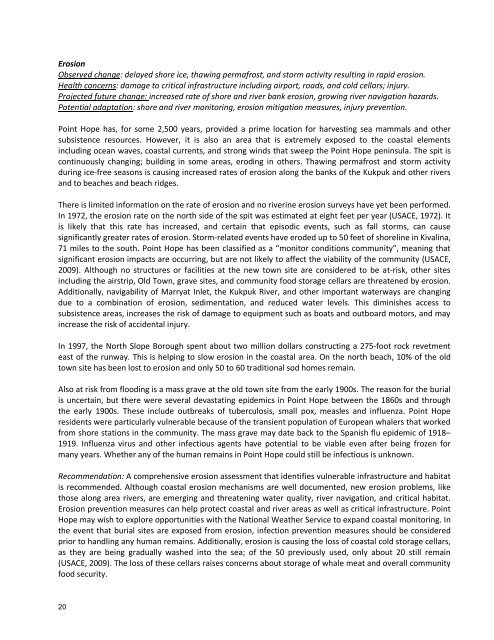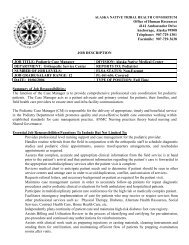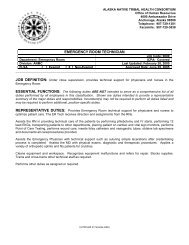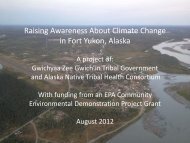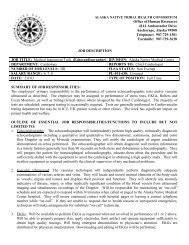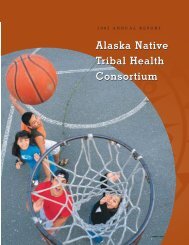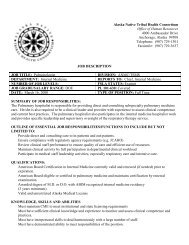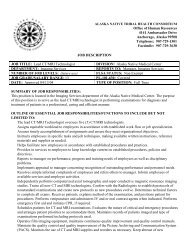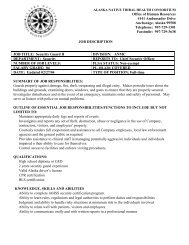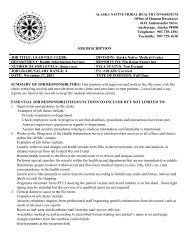Draft Final Climate Change and Health Impacts Point ... - ANTHC
Draft Final Climate Change and Health Impacts Point ... - ANTHC
Draft Final Climate Change and Health Impacts Point ... - ANTHC
You also want an ePaper? Increase the reach of your titles
YUMPU automatically turns print PDFs into web optimized ePapers that Google loves.
Erosion<br />
Observed change: delayed shore ice, thawing permafrost, <strong>and</strong> storm activity resulting in rapid erosion.<br />
<strong>Health</strong> concerns: damage to critical infrastructure including airport, roads, <strong>and</strong> cold cellars; injury.<br />
Projected future change: increased rate of shore <strong>and</strong> river bank erosion, growing river navigation hazards.<br />
Potential adaptation: shore <strong>and</strong> river monitoring, erosion mitigation measures, injury prevention.<br />
<strong>Point</strong> Hope has, for some 2,500 years, provided a prime location for harvesting sea mammals <strong>and</strong> other<br />
subsistence resources. However, it is also an area that is extremely exposed to the coastal elements<br />
including ocean waves, coastal currents, <strong>and</strong> strong winds that sweep the <strong>Point</strong> Hope peninsula. The spit is<br />
continuously changing; building in some areas, eroding in others. Thawing permafrost <strong>and</strong> storm activity<br />
during ice‐free seasons is causing increased rates of erosion along the banks of the Kukpuk <strong>and</strong> other rivers<br />
<strong>and</strong> to beaches <strong>and</strong> beach ridges.<br />
There is limited information on the rate of erosion <strong>and</strong> no riverine erosion surveys have yet been performed.<br />
In 1972, the erosion rate on the north side of the spit was estimated at eight feet per year (USACE, 1972). It<br />
is likely that this rate has increased, <strong>and</strong> certain that episodic events, such as fall storms, can cause<br />
significantly greater rates of erosion. Storm‐related events have eroded up to 50 feet of shoreline in Kivalina,<br />
71 miles to the south. <strong>Point</strong> Hope has been classified as a “monitor conditions community”, meaning that<br />
significant erosion impacts are occurring, but are not likely to affect the viability of the community (USACE,<br />
2009). Although no structures or facilities at the new town site are considered to be at‐risk, other sites<br />
including the airstrip, Old Town, grave sites, <strong>and</strong> community food storage cellars are threatened by erosion.<br />
Additionally, navigability of Marryat Inlet, the Kukpuk River, <strong>and</strong> other important waterways are changing<br />
due to a combination of erosion, sedimentation, <strong>and</strong> reduced water levels. This diminishes access to<br />
subsistence areas, increases the risk of damage to equipment such as boats <strong>and</strong> outboard motors, <strong>and</strong> may<br />
increase the risk of accidental injury.<br />
In 1997, the North Slope Borough spent about two million dollars constructing a 275‐foot rock revetment<br />
east of the runway. This is helping to slow erosion in the coastal area. On the north beach, 10% of the old<br />
town site has been lost to erosion <strong>and</strong> only 50 to 60 traditional sod homes remain.<br />
Also at risk from flooding is a mass grave at the old town site from the early 1900s. The reason for the burial<br />
is uncertain, but there were several devastating epidemics in <strong>Point</strong> Hope between the 1860s <strong>and</strong> through<br />
the early 1900s. These include outbreaks of tuberculosis, small pox, measles <strong>and</strong> influenza. <strong>Point</strong> Hope<br />
residents were particularly vulnerable because of the transient population of European whalers that worked<br />
from shore stations in the community. The mass grave may date back to the Spanish flu epidemic of 1918–<br />
1919. Influenza virus <strong>and</strong> other infectious agents have potential to be viable even after being frozen for<br />
many years. Whether any of the human remains in <strong>Point</strong> Hope could still be infectious is unknown.<br />
Recommendation: A comprehensive erosion assessment that identifies vulnerable infrastructure <strong>and</strong> habitat<br />
is recommended. Although coastal erosion mechanisms are well documented, new erosion problems, like<br />
those along area rivers, are emerging <strong>and</strong> threatening water quality, river navigation, <strong>and</strong> critical habitat.<br />
Erosion prevention measures can help protect coastal <strong>and</strong> river areas as well as critical infrastructure. <strong>Point</strong><br />
Hope may wish to explore opportunities with the National Weather Service to exp<strong>and</strong> coastal monitoring. In<br />
the event that burial sites are exposed from erosion, infection prevention measures should be considered<br />
prior to h<strong>and</strong>ling any human remains. Additionally, erosion is causing the loss of coastal cold storage cellars,<br />
as they are being gradually washed into the sea; of the 50 previously used, only about 20 still remain<br />
(USACE, 2009). The loss of these cellars raises concerns about storage of whale meat <strong>and</strong> overall community<br />
food security.<br />
20


